The stock market is driven by greed and fear. And when the latter takes full control of the wheel, as is the case right now, value-minded income investors need to stay sharp.
It’s been more than a decade since we’ve gotten a true bear market, which tends to bring stock valuations more in line with historical norms. Even so, since 2009, we’ve experienced a few quick drawdowns that resulted in more reasonable prices, and more generous yields, than this expensive market typically offers.
There was the August 2014 correction triggered by China’s “Black Monday.” There was our near-bear experience in 2018, prompted by tariff fears, Fed rate hikes and the partial government shutdown. And right now, the stock market is trying to deal with a bubbling health crisis that represents its first real challenge in months.
Broadly speaking, stocks haven’t suffered anywhere near the losses they absorbed in 2014 and 2018. The emergence of the deadly Wuhan coronavirus has so far, at its worst, produced a five-session, 2.6% drawdown in the S&P 500 between Jan. 21 and Jan. 27, which is a relative drop in the bucket.
But that’s also the market’s deepest slump in nearly three months. And more importantly, the coronavirus’ potential effects on trade, travel and energy has created a “flash sale” of double-digit dips across several industries.
But be careful.
While value is a core component of every buying decision I make, I also look for the rare “green on the screen” when markets are panicking. In other words, I want to see which stocks hold up well when everything is flashing red.
Specifically, I want to see which high yielders are holding up relative to the market. Substantial dividend income is the surest path to a cozy retirement, but what good are those payouts if the stocks are turning tail every time the market flops?
These three 6%+ payers have hummed through the market’s recent hiccup:
- Cohen & Steers Total Return Realty (RFI), 6.4% yield
- Compass Diversified Holdings (CODI), 6.0% yield
- B&G Foods (BGS), 11.5% yield

Outperformance in the face of broader-market turbulence is a sign of “relative strength,” which means (at least at the moment) that the stocks are acting better than the market.
Just remember to take the bigger picture into account, too.
Take B&G Foods, for instance. This small-cap consumer staples company, which owns a few well-known brands such as Ortega and Green Giant, has suffered from myriad problems over the past few years. Some of its brands are losing share to rivals; more recently, packaging costs and tariff issues are bringing up expenses; long-term debt of $2.1 billion is roughly eight times the $267 million in cash it has on hand.
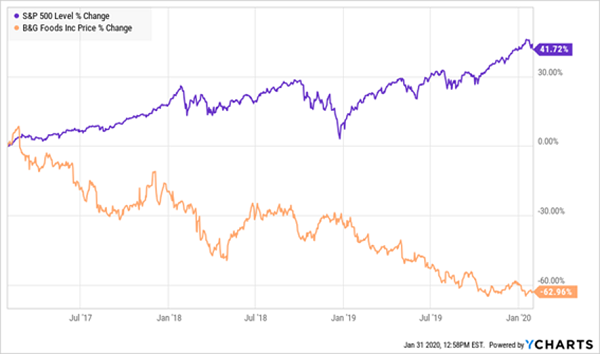
It’s B&G Foods’ tanking shares—not dividend growth, which has been glacial over the past three years—that’s propping up its super-sized yield. And that dividend looks shaky, at 115% of expected 2019 full-year earnings .
Clearly, BGS isn’t a post to tie your horse to.
But let me show you what happens when you buy a sustainable outperformer in the midst of a crisis.
In the disastrous final quarter of 2018, healthcare-focused Medical Properties Trust (MPW), a triple-net hospital REIT, put up an 8% gain that most investors would’ve been thrilled about in any year. It was especially impressive given the fact that the S&P 500 was dive-bombed by 14% over the same time frame.
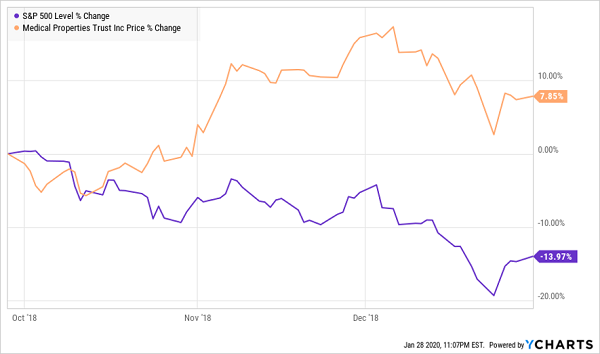
What happened next? This strong stock got even stronger, churning out 28% total returns since the start of 2019—good enough to beat both the S&P 500 and VNQ by roughly 15 percentage points.
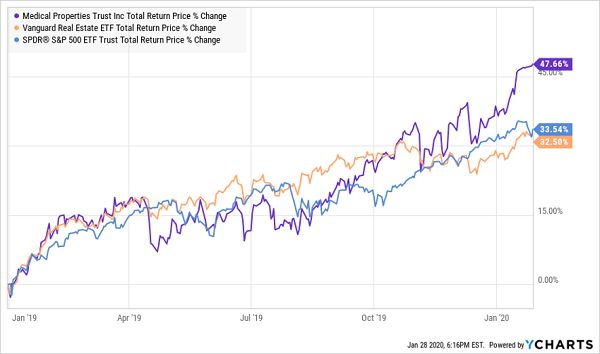
In fact, it even outperformed over this recent weak spell.
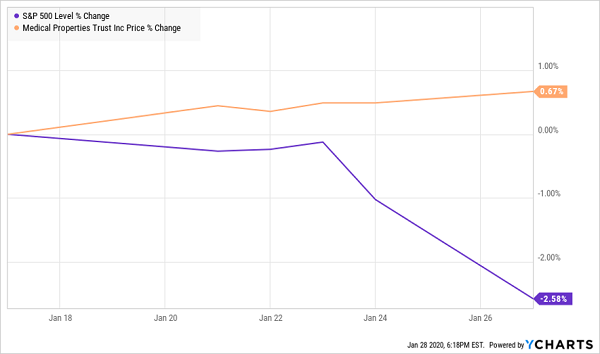
“Perfect” Retirement Income: Start 2020 By Quadrupling Your Yield
I still respect the work that founder Ed Aldag is doing at Medical Properties Trust, but the easy money’s been made.
I should know. My subscribers rode MPW to a 105% total return between 2016 and 2019.
But we’ve since moved on to more fertile ground—a set of high-yield picks that are built to withstand what could be a nauseating 2020 while delivering 3x-4x the income that traditional “blue chips ‘n’ bonds” portfolios generate.
I call them the “Perfect Income” stocks, and so far, they’ve lived up to their name.
Have you looked to the Internet for popular 2020 dividend recommendations? I have, and I don’t like what I’ve found. Several of these “best-of” lists include the likes of Merck (MRK)—a perfectly fine Big Pharma name with a decent dividend track record, but a yield of 2.8% at current prices.
If that sounds “safe” to you, consider this: Even if you had a million dollars invested in MRK, you’d only bring home $28,000 in annual income.
What’s safe about that?
“Safe” is being able to afford your mortgage, keep your lights on and eat right.
“Safe” is being able to finance all the extras in retirement that you’ve been working so hard for decades to enjoy.
And “safe” is being able to do all that without having to rely on once-in-a-generation bull runs to keep a batch of mediocre holdings afloat.
You can secure that level of safety from the dividend-rich stocks in my “Perfect Income Portfolio.”
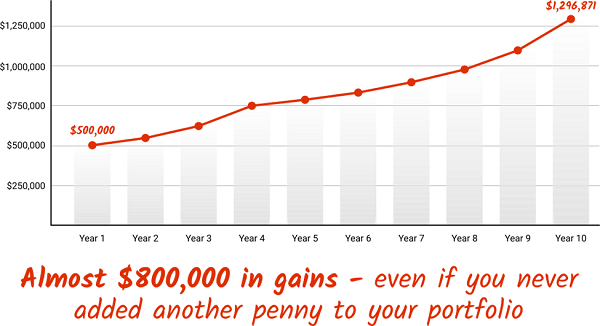
This is 2020, not 2000. 10-year Treasuries don’t pay 6.6% anymore—they pay 2.6%. The 2%-3% yields on most Dow stocks just won’t cut it, either.
But my readers are locking down double, triple, and in a few cases, quadruple the income they were generating from their old income portfolios. Every couple of weeks a reader will send me a success story like that, and that’s what keeps me hungry and neck-deep in research to make sure the Perfect Income Portfolio never skips a beat.
This is simple buy-and-hold investing. No options. No swing trading. No crypto. No forex. I provide you with a set of tickers from under-the-radar, contrarian income plays that can quickly build your wealth. If the stock is below the buy-under price, you pull the trigger.
That’s it.
It might sound too good to be true, but I’ve got the receipts to back it up. Check out this strategy’s past 10 years of returns, and you’ll see why I call it the “Perfect Income Portfolio.”
